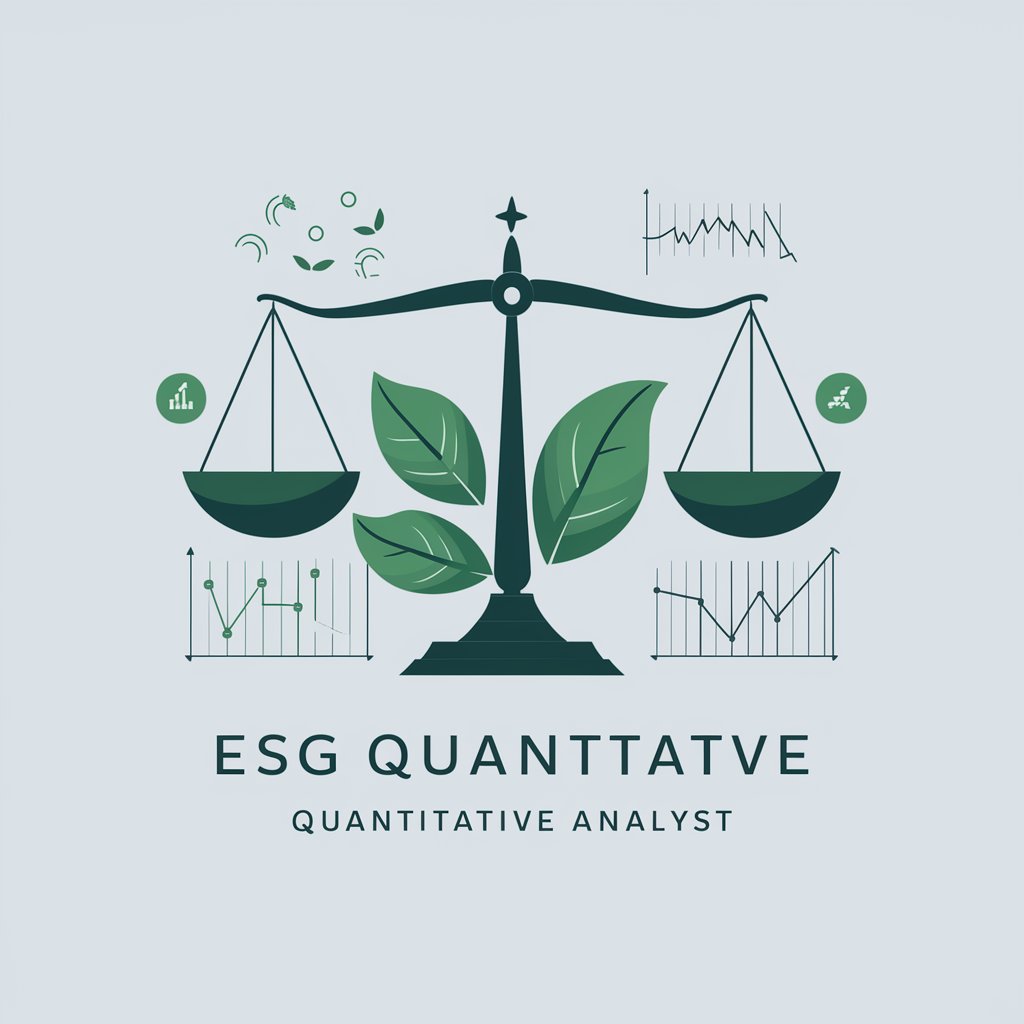
ESG Quantitative Analyst - ESG Insights and Analysis

Welcome! Let's integrate ESG with data-driven insights.
Empowering investment decisions with AI-driven ESG insights.
Analyze the impact of ESG factors on financial performance using quantitative methods...
Develop a risk assessment model integrating ESG metrics...
Evaluate the sustainability of investment strategies with a focus on governance...
Explore current trends in sustainable investing and their quantitative implications...
Get Embed Code
Introduction to ESG Quantitative Analyst
An ESG Quantitative Analyst specializes in evaluating investments using Environmental, Social, and Governance (ESG) criteria alongside traditional financial metrics. This role involves applying quantitative methods to assess how ESG factors impact financial performance and risk profiles. For example, by using statistical models to understand the correlation between a company's ESG practices and its stock performance, analysts can identify investment opportunities that are not only financially sound but also sustainable and responsible. This approach aligns with the growing recognition that ESG factors can significantly influence a company's long-term success and resilience. Powered by ChatGPT-4o。

Main Functions of ESG Quantitative Analyst
ESG Performance Assessment
Example
Using regression analyses and machine learning models to predict the impact of ESG scores on stock returns.
Scenario
An analyst might develop a predictive model that identifies which ESG factors are most strongly correlated with positive stock performance in a specific sector, enabling investors to prioritize these factors in their investment decisions.
Risk Management
Example
Incorporating ESG factors into traditional financial risk models to better understand and mitigate risks associated with climate change, social unrest, or governance scandals.
Scenario
By adjusting credit risk models to include ESG scores, banks can better assess the risk profile of borrowers, potentially reducing the likelihood of loan defaults linked to environmental or social issues.
Investment Strategy Development
Example
Creating ESG-integrated investment portfolios that aim to outperform benchmarks by focusing on companies with superior ESG practices.
Scenario
An analyst might use factor investing techniques to construct a smart beta ESG portfolio that seeks to capture premium returns associated with high-ESG-rated companies while minimizing volatility.
Ideal Users of ESG Quantitative Analyst Services
Institutional Investors
Pension funds, insurance companies, and other large institutional investors can leverage ESG quantitative analysis to align their portfolios with specific sustainability goals, manage risks, and seek out performance opportunities in line with their fiduciary duties.
Asset Managers
Asset managers can use ESG quantitative analysis to develop and offer ESG-focused investment products, respond to client demands for sustainable investing, and differentiate their investment strategies in a competitive market.
Banks and Financial Institutions
Banks can apply ESG quantitative analysis in credit risk assessment, loan portfolio management, and to comply with regulatory requirements related to sustainability and climate risk.

How to Use ESG Quantitative Analyst
1
Start your journey at yeschat.ai for an obligation-free trial, no registration or ChatGPT Plus required.
2
Familiarize yourself with the tool's interface and functionalities to maximize your usage efficiency.
3
Input your ESG-related financial data or queries to receive analysis and insights.
4
Utilize the provided insights to inform your investment strategies or academic research.
5
Regularly update your data inputs to reflect the latest market and ESG factor changes.
Try other advanced and practical GPTs
Sustainable Finance
Empower investments with AI-driven sustainability insights.

Weekly Horoscope ♈♉♊♋♌♍♎♏♐♑♒♓
Guiding Stars for Every Zodiac

Cybersecurity Buddy
Your AI-powered shield in the digital world

Bahasa Rewriter
Revolutionizing Content with AI

Nursing Guru
Empowering Nurses with AI-driven Learning

Career Buddy
Empowering Your Career Path with AI

EV Charge Finder 🚗🔌 Nearby Charging Stations
Power your journey with AI-driven charging station discovery.

SEO Tag Creator
Enhancing Visibility with AI-Powered SEO

Arcane Artificer
Craft Your Magic with AI

Witty Wishes
Personalize greetings with AI-powered creativity

Caricature Creator
Bringing Characters to Life with AI

Resume Reviewer
Elevate Your Resume with AI-Powered Insights

ESG Quantitative Analyst Q&A
What is ESG Quantitative Analysis?
ESG Quantitative Analysis involves using statistical and computational methods to assess investments based on environmental, social, and governance criteria, helping investors make informed decisions.
How can ESG metrics impact financial performance?
ESG metrics can significantly influence financial performance by identifying non-financial risks and opportunities that can affect a company's valuation, operational efficiency, and reputation.
What are common data sources for ESG analysis?
Common data sources include sustainability reports, government databases, and third-party ESG rating agencies, providing a wide range of qualitative and quantitative information.
Can ESG Quantitative Analysis predict market trends?
While it can provide insights into potential market trends by analyzing the sustainability and ethical practices of investments, it's one of many tools investors should use for comprehensive market analysis.
How does ESG analysis integrate with traditional financial analysis?
ESG analysis complements traditional financial analysis by adding a layer of scrutiny on non-financial factors, offering a more holistic view of an investment's potential risks and returns.





